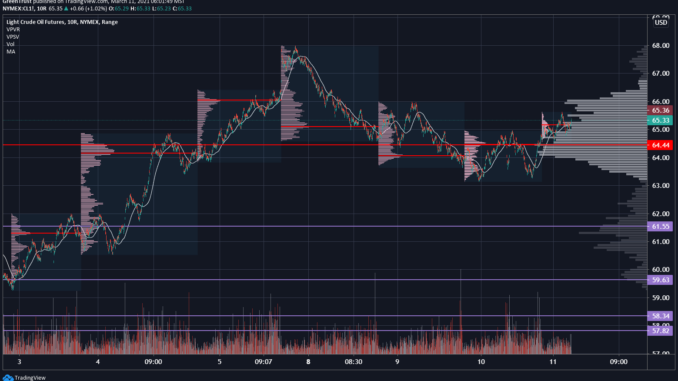
Singapore — 0308 GMT: Crude oil futures rose during mid-morning trade in Asia March 11 as bullish US products data from the Energy Information Administration negated a large build in US crude inventories, with the market also gaining support from the US Congress’ approval for fiscal relief and the depreciation of the dollar.
At 11:08 am Singapore time (0308 GMT), the ICE Brent May contract was up by 53 cents/b (0.78%) from the March 10 settle to $68.43/b, while the April NYMEX light sweet crude contract was up by 54 cents/b (0.84%) to $64.98/b.
Data released by the EIA late March 10 showed a massive 13.8 million-barrel build in US crude inventories in the week ended March 5. The build pushed stocks to 498.4 million barrels, and at 6%, opened up the widest surplus to the five-year average since mid-January.
The build was larger than expected, as analysts surveyed by S&P Global Platts had forecast crude stocks to increase by only 2.7 million barrels. Regardless, the market barely flinched, and instead chose to focus its attention on the bullish products data.
According to the EIA, US gasoline inventories and distillate inventories plummeted, falling 11.8 million barrels and 5.5 million barrels, respectively.
The market was particularly reassured by indications of a rise in gasoline and distillate demand. Implied gasoline demand jumped by more than 7% on the week to 8.73 million b/d, the strongest since early November 2020, whereas implied distillate demand surged by more than 18% on the week to 4.49 million b/d, the strongest since November 2019.
“Overall [gasoline] demand was stronger, with apparent consumption hitting over 8 million b/d as vaccinations and better weather boosted road travel. In fact, congestion in New York is rising, while toll route traffic has risen the fastest since November 2019,” ANZ analysts said in a March 11 note.
Sentiment in the market also received a boost after the US House of Representatives approved a $1.9 trillion stimulus package on March 10, after the US Senate had voted in favor of the package on March 6.
The stimulus package is expected to increase oil and energy demand by expediting global economic recovery, according to Laurence Boone, the OECD’s chief economist, who told the Financial Times that it will add 1% to global economic growth.
During the March 11 morning trade, oil prices were also buoyed by the depreciation in the US dollar, which analysts said was the result of muted US inflation data bringing stability to US bond yields, and improving risk sentiment in the market. At 10:54 am, the March contract for the US dollar index was down 0.184% from the March 10 close at 91.795.
“A weaker dollar on Wednesday [March 10] supported energy prices along with better [economic] data,” Avtar Sandu, Philips Futures’ senior commodities manager said in a March 11 note. Sandu said that strong February credit growth in China and a robust increase in January manufacturing in France constituted the economic data supporting oil.



